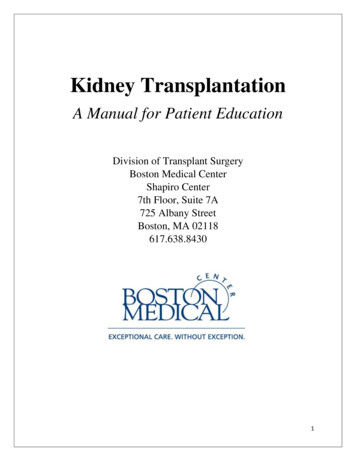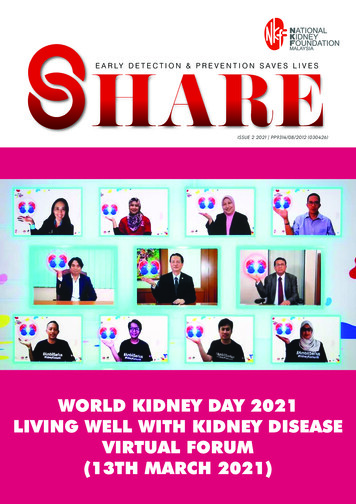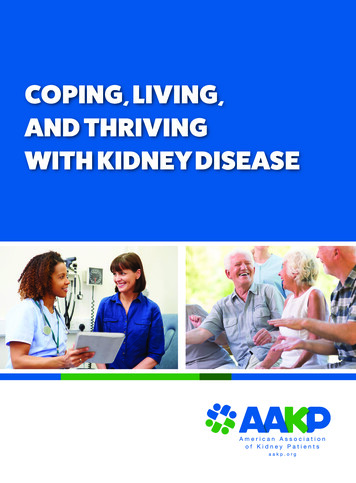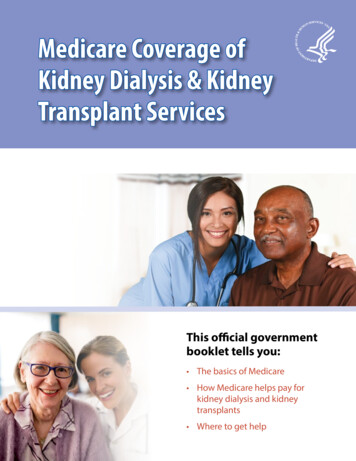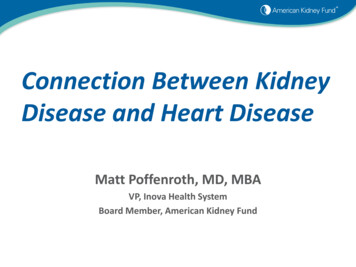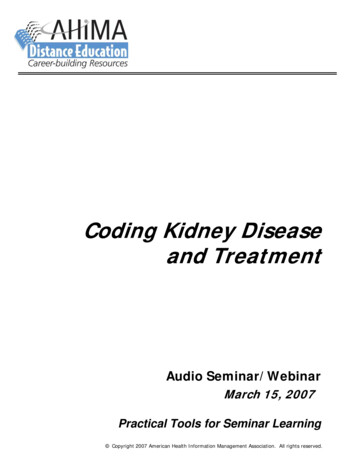
Transcription
Gebrie et al.Health and Quality of Life Outcomes(2022) n AccessRESEARCHPsychometric properties of the kidneydisease quality of life‑36 (KDQOL‑36)in Ethiopian patients undergoing hemodialysisMignote Hailu Gebrie1* , Hussen Mekonnen Asfaw2, Workagegnehu Hailu Bilchut3, Helena Lindgren4 andLena Wettergren4,5AbstractBackground: Health-related quality of life (HRQOL) has a direct association with increased morbidity and mortalityamong end stage renal disease patients. Valid and reliable instruments to measure the HRQOL of patients with endstage renal disease are therefore required. This study aimed to translate, culturally adapt and evaluate the psychometric properties of the Amharic version of the Kidney Disease Quality of Life-36 (KDQOL-36) instrument in Ethiopianpatients with end stage renal disease undergoing hemodialysis.Methods: The KDQOL-36 instrument was developed for individuals with kidney disease who are being treatedwith dialysis and includes both generic and disease-specific components. The KDQOL-36 was translated to Amhariclanguage and distributed to a cross-sectional sample of 292 hemodialysis patients. The psychometric evaluationincluded construct validity through corrected item-total correlation, confirmatory factor analysis and known groupanalysis. Convergent validity was evaluated by correlations between each of the three kidney disease targeted scales(symptoms/problems list, burden of kidney disease and effects of kidney diseases) and the European Quality of Life5D-5L and Visual Analog Scales. Regarding reliability, internal consistency and test–retest reliability were assessed.Results: Two hundred ninety-two patients with a mean age of 48 (SD 14.7) completed the questionnaire. Corrected item- total correlation scores were 0.4 for all items. Confirmatory factor analysis revealed a two χ2 /df was 4.4,Root Mean Square Error of Approximation (RMSEA) 0.108 (90% CI 0.064–0.095), Comparative Fit Index (CFI) 0.922,Tucker Lewis Index (TLI) 0.948 and Standardized Root mean-squared residual (SRMR) 0.058) and three χ2 /df 3.1,RMSEA 0.085 (90% CI 0.064–0.095), CFI 0.854, TLI 0.838 and SRMR 0.067) factor models for the generic anddisease specific components respectively. The mean scores of the three kidney disease targeted domains were correlated to the EQ-5D-5L & VAS with correlation coefficients of large magnitude (0.55–0.81). The reliability of the instrument was satisfactory (Cronbach’s alpha 0.81–0.91) and Intra-class correlation (ICC) 0.90–0.96).Conclusion: The Amharic version of the KDQOL-36 is a reliable and valid instrument recommended for assessmentof HRQOL of Ethiopian patients on hemodialysis.Keywords: Confirmatory factor analysis, End stage renal disease, KDQOL-36, Quality of life, Reliability, Validity,Hemodialysis, Ethiopia*Correspondence: elatman.hailu86@gmail.com1College of Medicine and Health Sciences, School of Nursing, Universityof Gondar, Gondar, EthiopiaFull list of author information is available at the end of the articleBackgroundEnd stage renal disease (ESRD) is a public health problem resulting in high morbidity and mortality worldwide[1–4]. Globally in 2017, chronic kidney disease (CKD) The Author(s) 2022. Open Access This article is licensed under a Creative Commons Attribution 4.0 International License, whichpermits use, sharing, adaptation, distribution and reproduction in any medium or format, as long as you give appropriate credit to theoriginal author(s) and the source, provide a link to the Creative Commons licence, and indicate if changes were made. The images orother third party material in this article are included in the article’s Creative Commons licence, unless indicated otherwise in a credit lineto the material. If material is not included in the article’s Creative Commons licence and your intended use is not permitted by statutoryregulation or exceeds the permitted use, you will need to obtain permission directly from the copyright holder. To view a copy of thislicence, visit http:// creat iveco mmons. org/ licen ses/ by/4. 0/. The Creative Commons Public Domain Dedication waiver (http:// creat iveco mmons. org/ publi cdoma in/ zero/1. 0/) applies to the data made available in this article, unless otherwise stated in a credit line to the data.
Gebrie et al. Health and Quality of Life Outcomes(2022) 20:24resulted in 1·2 million deaths, more than did tuberculosis or Human Immunodeficiency Virus (HIV) [5]. It isthe terminal phase of CKD, where the kidneys experiencecomplete or near complete failure and renal replacementtherapy is needed to sustain life [6–8].The worldwide prevalence of ESRD ranges from 2447cases patients per million population (pmp) in Taiwanto 10 cases pmp in Nigeria. Much less is known in allof Africa, due to lack of renal registry, with the highest prevalence of ESRD in Tunisia (713 pmp) and Egypt(669 pmp). However, it is predicted that the low-incomecountries of Asia and Africa will be where more than 70%of patients with ESRD will live by the year 2030 [9]. InEthiopia, the incidence of CKD is increasing as a result ofincreasing prevalence of CKD risk factors such as hypertension and diabetes mellitus [10].Hemodialysis is one of the treatment methods, contributing to increased survival in patients with ESRD [11, 12].However, patients with hemodialysis suffer from a multitude of problems including sleep disorders, peripheralneuropathy, infection, fatigue, stress, anxiety, depression,cognitive difficulties pain and sexual dysfunction [13–15]. Hence, assessing the health-quality of life (HRQOL)of ESRD patients is essential as it is an independent predictor of patient’s treatment outcome.Several instruments have been developed to measureHRQOL in ESRD patients [16–18]. The kidney diseasequality of life (KDQOL-36) survey is a disease-specificmeasure of HRQOL including both generic and diseasespecific components. The KDQOL-36 contains 5 subscales and is one of the most commonly used measuresfor assessment of patients with kidney disease [16, 19].The instrument has been translated and validated in various languages [20–23], however, to date its psychometric properties have not been confirmed in an Ethiopiapopulation. Therefore, the objective of this study was totranslate, culturally adapt and evaluate the psychometric properties of the KDQOL-36 questionnaire whenused among Ethiopian patients with ESRD undergoinghemodialysis.MethodsThe KDQOL‑36 instrumentThe KDQOL-36 was derived from the original 134item KDQOL instrument [24]. The KDQOL-36 versionincludes the Medical Outcomes Study’s 12-Item ShortForm Health Survey (SF-12) as a generic core and the24-item kidney disease targeted questionnaire [25, 26].The items of the SF-12 are summarized into the PhysicalComponent Summary (PCS) score and the Mental Component Summary (MCS) with response alternatives varying from 2- to 6-point scales [27, 28]. The kidney diseasetargeted instrument includes three scales: SymptomsPage 2 of 9and Problems (12 items), Burden of Kidney Disease (4items), and Effects of Kidney Disease (8 items); all itemshave 5 response options. The scale scores of the KDQOL36 questionnaire (PCS, MCS, symptoms and problems,burden of kidney disease, effects of kidney disease,) aretransformed to 0 to 100 with higher scores indicatingbetter HRQOL [24, 29]. We used the K DQOLTm-36 scoring program (V 2.0) from the University of California,Los Angeles (UCLA) to compute the scale scores. Thisprogram is available free for download online (http:// www. rand. org/ health/ surve ys tools/ kdqol. html).Translation of the KDQOL‑36 into amharic languageThe KDQOL-36 was translated from English intoAmharic by two professional translators (native Amharicspeakers with fluency in English). The translators hada Master’s degree in English Language and Literature.The translated Amharic versions were then reviewed bya committee of experts including the investigators, theoriginal translators, nurses working in a hemodialysisunit, a nephrologist and experts in instrument development and translation. Some minor changes were madebefore the items were translated back into English bytwo other independent professional translators and werethen compared to the original instrument. There wererepeated back translations for some items for which deviations were encountered until matching was seen to besufficiently good to ensure that the Amharic version didnot differ from the original instrument. Finally, cognitivetesting was conducted on 10 ESRD patients undergoing hemodialysis to determine its cultural appropriateness and acceptability including instructions, items andresponse choices [29] which resulted in rewording a fewitems. Translation of the English KDQOL-36 to Amharicwas performed according to the basic guidelines fortranslating surveys (see https:// www. rand. org/ health- care/ surve ys tools/ about trans latio ns. html).Sample and settingsA cross-sectional study was conducted at two governments (Menelik II and Zewditu memorial) and six private (Ethio-tebib, Hallelujah, Hayat, Bethel, MABD andFlow) hospitals/dialysis centers situated in Addis Ababa,Ethiopia. Data for the psychometric evaluation were collected over a period of one month, January to February2021, from patients receiving outpatient maintenancehemodialysis. All patients who fulfilled the inclusion criteria (ESRD patients aged 18 years, maintained on regular hemodialysis treatment for 3 months and speakingAmharic) were approached regarding possible participation in the study. Hemodialysis patients who providedtheir consent were then interviewed by trained researchassistants and their medical records were consulted to
Gebrie et al. Health and Quality of Life Outcomes(2022) 20:24obtain clinical data. Participants were asked to respondto study-specific and standardized items (KDQOL36). Two weeks later, a subsample (n 50) was asked torespond to the Amharic KDQOL-36 again to assess thetest–retest reliability.Additional measuresIn addition to the KDQOL-36, participants were askedto complete the Amharic European Quality of Life 5D-5Land Visual Analog Scale (EQ-VAS) [30]. The EQ-5D-5Lis a generic instrument, developed by the European quality of life (EuroQol) Group consisting of five dimensions:mobility, self-care, usual activities, pain/discomfort, andanxiety/depression and an EQ-VAS with a 5-point Likert scale (no problems, slight, moderate, severe, extreme/unable). The EQ-VAS is numbered from 0 to 100, where0 indicated the worst imaginable health and 100 was bestimaginable health [31]. Scores were converted to 0 to100%.Statistical analysisSTATA version 14 was used for statistical analysis [32].Normality was assessed for the outcome variables usingthe Shapiro Wilk test. Patients’ demographic and clinicalcharacteristics were summarized using descriptive statistics (percentages, frequencies, means, standard deviations). Descriptive statistics for the five separate domainsof the KDQOL-36 were calculated with means andstandard deviation [29].Data qualityData quality was assessed by examination of missing values for each item of the KDQOL-36. Furthermore, weevaluated whether all response alternatives were used forall items as well as floor and ceiling effects. Ceiling effectwas measured by the proportion of people rating thehighest possible score while floor effects were measuredby the proportion of people rating the lowest possiblescore. These effects were considered significant if 15%of the patients scored the lower/higher values [32].Construct validityConstruct validity of KDQOL-36 was assessed by usingcorrected item scale correlation using cut-off scores 0.4to indicate adequate correlation [33]. Confirmatory factor analysis (CFA) was employed to test the model fitbetween the observed and the hypothetical measures.CFA is a method of choice when the researcher has priorknowledge of the basic latent variable construction [34].The SF-12 and the kidney disease targeted questionnairewere analyzed separately because they are different questionnaires each having their own unique contribution tothe assessment of HRQOL. The validity of SF-12 healthPage 3 of 9survey would be supported if the hypothesized physical and mental component summary scales were identified [27]. CFA would support the disease-targeted partif a three-factor structure was achieved [29]. Model fitwas assessed using normed Chi-Square (χ2/df ), RootMean Square Error of Approximation (RMSEA), Comparative Fit Index (CFI), Tucker Lewis index (TLI) andStandardized Root mean-squared residual (SRMR). Normed Chi-Square should be 0–2 for good fit and 3 foran acceptable fit. Values between 0.05 and 0.08 suggestreasonable RMSEA and lower values represent betterfit [35]. CFI & TLI 0.9 indicate good fit and that SRMRshould be 1.0 to consider the model is favorable [36].We used Maximum likelihood estimation (MLE) [34].Convergent validity was evaluated by correlation coefficients between the three kidney disease targeted scaleswith the EQ-5D-5L and EQ-VAS. Pearson’s correlation coefficient was calculated where values 0.10–0.29,0.30–0.49 and 0.49 represents small, moderate and largemagnitude, respectively [37]. It was hypothesized that thethree kidney disease specific domains would have moderate to large coefficients with the ED-5D-5L and VAS,respectively.Known group analyses were conducted to test how wellthe questionnaire discriminates between subgroups ofthe study sample that differed in diabetes status, examining a hypothesis supported by previous research [38,39]. It was expected that patients without diabetes wouldhave better HRQOL than diabetic patients. Independentt-tests and an analysis of variance (ANOVA) were used toevaluate the differences.ReliabilityReliability included internal consistency as well as test–retest. Internal consistency was estimated using Cronbach alpha coefficient for the different domains of theinstrument. Cronbach’s alpha between 0.70–0.90 is suggested to reflect adequate internal consistency [40].Intra-class correlation coefficient (ICC) was computed toassess test–retest reliability where values 0.9, 0.75–0.90,0.5–0.75 and 0.5 indicates excellent, good, moderateand poor reliability respectively [41].ResultsSocio‑demographic characteristicsThe total sample included 292 patients (response rate96%) on maintenance hemodialysis with a mean age 48(SD 14.7), please see Table 1.Data qualityThere were no missing data. All response alternativeswere used for all items. Descriptive statistics includingfloor and ceiling effects are shown in Table 2.
Gebrie et al. Health and Quality of Life Outcomes(2022) 20:24Page 4 of 9Table 1 Socio-demographic characteristics of patients with ESRD undergoing hemodialysis in Addis Ababa, Ethiopia, 2021 (n 292)VariablesSexAge (years), M (SD)CategoryNumbers (n)Percent (%)Male18764Female1053685.648 (SD 14.7)ResidenceIn Addis Ababa250Outside Addis Ababa4214.4Marital statusEver married23279.5Single6020.5Educational statusNot read and write268.9Read and write299.9Primary (1–8)3311.3Secondary (9–10)3211.0Preparatory (11–12)5217.8Vocational103.4Diploma and 47.9Hemodialysis session per week1 times155.12 times12542.83 times15252.1FundingYes7024No22276Family historyYes113.8No28196.2Duration since start of hemodialysis, M (SD)2.4 years (SD 2.1)Vascular access typeArteriovenous fistula21874.7Arteriovenous graft3010.3Permanent catheter3110.6Temporary catheter134.5M mean; SD standard deviationTable 2 Descriptive statistics for the KDQOL-36 questionnaire among hemodialysis patients in Addis Ababa, Ethiopia, 2021 (n 292)DomainsNo. of itemsMean (SD)Range of items mean (SD)Floor/ceilingeffects, %Cronbach’s alphaKidney disease targeted scalesSymptoms/problems list1268.19 (19.52)57.10–76.28(24.5–29.8)0/1.00.907Effects of kidney disease857.13 (18.28)39.29–66.44(22.1–30.9)0/00.827Burden of kidney disease435.57 tem health survey (SF-12)SF-12 PCS635.59 (8.80)24.32–43.49(29.8–47.1)0/00.813SF-12 MCS638.85 (13.63)38.56–47.05(28.6–47.1)0/00.892Construct validityThe corrected item-total correlation coefficients forall items were between 0.41 to 0.85 (data not shown),thus showing adequate correlation. The CFA resultsfor SF-12 showed that χ2/df was 4.4, RMSEA 0.108(90% CI 0.064–0.095), CFI 0.922, TLI 0.948 andSRMR 0.058 (Fig. 1). Since the RMSEA was relativelyhigh, we re-specified the model (supplementary file 1).The model outputs were similar and as the uncorrectedmodel fitted well with the originally hypothesizedtwo-factor model which forms the basis of the PCSand MCS this was selected. Similarly, in the kidneydisease related scales (symptoms/ problems, effectsand burden), the data fitted with the hypothetical
Gebrie et al. Health and Quality of Life Outcomes1.52I62.64I7(2022) 20:24Page 5 of .6PCS1.66.74I41.44.87.79.871I5.57.71.5I81.51.3Fig. 1 A two-factor model for the SF-12 PCS & MCS scales from confirmatory factor analysis among hemodialysis patients in Addis Ababa, Ethiopia,2021three factor model with χ2/df 3.1, RMSEA 0.085(90% CI 0.064–0.095), CFI 0.854, TLI 0.838 andSRMR 0.067) (Fig. 2). Model re-specification wasconsidered since the RMSEA & SRMR were a bit highand the CFI & TLI were a bit low. Even though somevariability was found that the data couldn’t explain, theresults were very close to the uncorrected model (supplementary file 2), and we decided to use the uncorrected one. Thus, the kidney disease targeted partsof the KDQOL-36 instrument was revealed as a threefactor model as it was hypothesized. The factor loadings of all items in both parts (SF-12 and diseases specific) were positive and exceeded the threshold of 0.4,which indicates considerable interpretability of original factor structure.The associations between the three kidney-diseasespecific domains and the EQ-5D-5L and the EQ-VASare presented in Table 3. Moderate to strong correlations were evidenced between KDQOL sub scales andthe EQ-5D-5L as well as the sub scales and VAS.Regarding known group validity, patients with diabetes had significantly lower scores for the effectsof kidney disease, SF-12 PCS and SF-12 MCS scales(Table 4).ReliabilityCronbach’s alpha values for the five subscales exceeded0.80 (Table 2). With regard to test–retest reliability, thesubscales had an ICC value ranging between 0.90 to 0.96(data not shown).DiscussionIn this study, we evaluated the psychometric propertiesof the translated and culturally adapted Amharic versionof KDQOL-36. Our results indicate that the Amharicversion of the KDQOL-36 with the given response alternatives is satisfactory for use among patients who understand the Amharic language. Furthermore, the floor andceiling effects of the Amharic version of the KDQOL-36instrument were minimal which is in line with an American study [42]. However, it contrasts with findings fromanother study in the USA which found a significant flooreffect in the ‘burden of kidney disease’ and ‘effects ofkidney disease’ subscales [22]. The difference in findingscould be explained by the reason why psychometric testing of self-report measures is required for use in differentlanguages and on patients from different cultural backgrounds [43]. The minimal floor/ceiling effects indicate
Gebrie et al. Health and Quality of Life Outcomes13.33I13(2022) 20:24Page 6 of 25.59I26.693.3222.4.572I27.681.7I282.22.62Fig. 2 A three-factor model for the disease-targeted scales obtained from confirmatory factor analysis among hemodialysis patients in AddisAbaba, Ethiopia, 2021Table 3 Correlation between the domains of the Amharic version of the KDQOL-36 and the EQ-5D-5L and the VAS amonghemodialysis patients in Addis Ababa, Ethiopia, 2021 (n 292)DomainsNo. of itemsVAS correlation (r) with Pvalue 0.0001EQ-5D-5L correlation (r)with P value 0.0001Symptoms/problems list120.5850.683Effects of kidney disease80.6940.803Burden of kidney disease40.5480.603Kidney disease targeted scales
Gebrie et al. Health and Quality of Life Outcomes(2022) 20:24Page 7 of 9Table 4 Differences on scale scores of the KDQOL-36 among hemodialysis patients in Addis Ababa, Ethiopia, 2021VariablesKDQOL-36 sub scales (mean, SD)Symptoms/problems listEffects of kidney diseaseBurden of kidney disease SF-12 PCSSF-12 MCSDiagnosis of diabetesYes (103)73.250.728.133.935.5No (188)76.156.829.836.340.6P value0.1440.015*0.5660.024*0.006**Statistically significantthat the scales can accurately measure the concept bycapturing the deterioration or improvement in the courseof the disease along with hemodialysis therapy.All correlation coefficients in the corrected itemtotal correlation testing of the Amharic version ofthe KDQOL-36 were above 0.4 confirming constructvalidity of the Amharic version instrument. In linewith the previous study in Singapore [23], the UnitedStates [42], China [44] and Malaysia [45], our data fitthe three factor structure (symptoms/ problems list,burden of kidney disease and effects of kidney disease on kidney life). For the 12-item health survey, wefound that a two factor structure (PCS and MCS) as wehad hypothesized based on the SF-12 item health survey construction [27]. The factor loadings of all itemsin the disease-targeted scales and SF-12 health surveyexceeded 0.4.The correlations of the three kidney disease targetedscales with the EQ-5D-5L and EQ-VAS were all in theexpected direction and the coefficients were of largemagnitude supporting convergent validity of thesescales. This finding was comparable with results fromprevious studies [20, 45]. The Amharic version of theKDQOL-36 established evidence of known group validity as the scale scores were able to discriminate betweensubgroups of patients in relation to diabetes status. Inthis study, patients with diabetes had a worse qualityof life than those without diabetes as expected and thereason could be complications resulted from the disease. This finding was supported by other recent studiesevaluating the quality of life of ESRD patients [38, 39,42, 46].In our study, the three kidney disease targetedscales showed good internal consistency (Cronbach’salpha 0.8) in accordance with previous studies conducted in China [44], Malaysia [45], Thailand [20],Korea [47] and the United States [22, 42]. Similarly, thegeneric part of the instrument showed good internalreliability, which was comparable to previous studies inMalaysia [45], Iran [48], India [49] and Singapore [23]. Attwo-weeks test–retest, the ICC value ranged 0.090–0.961for all the five scales, which was consistent with previousstudies [20, 49, 50]. Thus, the Cronbach’s alpha and ICCvalues suggested that the Amharic version of KDQOL-36instrument is reliable.Strengths and limitationsThis study has several strengths. First, with a large sample (response rate 96%) including patients from government as well as private hospitals, our sample wasrepresentative of the population undergoing hemodialysis in Addis Ababa, Ethiopia. Second, sample size ofapproximately 300 patients enabled rigorous statistical analyses to evaluate validity (construct and knowngroups validity). There are also a few limitations to beconsidered when concluding our results. Amharic is themost commonly used language in the country. Still, twopatients were excluded as they did not speak or understand Amharic, and if they represent a subgroup thatmay perceive the items of the questionnaire in a differentway is not known. The study collected data by face-toface interviews though self-administration, a procedurecommonly practiced in administering the KDQOL-36instrument. We choose this mode of administration asconsiderably large proportion of the population in Ethiopia cannot read and write and participants in pilot interviews expressed that they preferred to be interviewed infront of instead of filling out the questionnaire by themselves. It should also be noted that a higher proportionof the study participants was well educated compared tothe population in the country as a whole. However, thisreflects the actual population receiving hemodialysis dueto kidney disease and not to be considered a selectionbias. Additionally, despite the fact that we recruited 292patients, the test–retest analysis was based on a smallerconvenient portion of this group (50 patients). This couldpossibly inject a selection bias in to our test–retest analysis and skew the results. However, when compared to therest of the cohort, it exhibited no significant differencesin demographic variables.
Gebrie et al. Health and Quality of Life Outcomes(2022) 20:24ConclusionThe KDQOL-36 in the Amharic language appears to bevalid and reliable for measuring HRQOL of Ethiopianpatients with end stage renal disease undergoing hemodialysis. The measure is recommended for use in clinicalresearch in Ethiopia.AbbreviationsCKD: Chronic kidney disease; CFA: Confirmatory factor analysis; EQ-VAS: European quality of life visual analog scale; ESRD: End stage renal disease; HRQOL:Health-related quality of life; ICC: Intra-class correlation; KDQOL-36: Kidneydisease quality of life-36; MCS: Mental component summary; PCS: Physicalcomponent summary; SF-12: Short form-12; QOL: Quality of life.Supplementary InformationThe online version contains supplementary material available at https:// doi. org/ 10. 1186/ s12955- 022- 01932-y.Additional file 1: A re-specified two-factor model for the SF-12 PCS& MCS scales from confirmatory factor analysis among hemodialysispatients in Addis Ababa, Ethiopia, 2021.Additional file 2: A re-specified three-factor model for the diseasetargeted scales obtained from confirmatory factor analysis among hemodialysis patients in Addis Ababa, Ethiopia, 2021.Authors’ informationMignote Hailu Gebrie is assistant Professor at the School of Nursing, Collegeof Medicine and Health Sciences, University of Gondar, Ethiopia. She has aBachelor of Science in Nursing (BSN) and MSN in Adult Health Nursing.Hussen Mekonnen, assistant professor of public health, College of HealthSciences, School of Nursing & Midwifery, Department of Nursing, Addis Ababa,Ethiopia.Workagegnehu Hailu, an assistant professor in the department of Internal Medicine, University of Gondar, Ethiopia. He is an internist and nephrologist with over 10 years of experience in , research and clinical practice.Helena Lindgren holds a position as senior lecturer (Associate professor)and Head of Division for Reproductive Health at Karolinska Institute, Sweden.She is also Visiting Professor at University of Gondar, Ethiopia.Lena Wettergren, Professor at Uppsala University, Department of PublicHealth and Caring Sciences and is associated with the Karolinska Institutet,Sweden. She is also Visiting Professor at University of Gondar, Ethiopia.AcknowledgementsOur heartfelt gratitude goes to University of Gondar for financial support. Theauthors would like to thank the respective hospitals and study participantswho chose to participate in this study and to Rahawa Yousuf at the Universityof Gondar for editorial assistance with this manuscript.Authors’ contributionsMH together with LW conceived and planned the study. MH is the principalinvestigator of the project and led the translation process including cognitiveinterviewing, and the data collection for the psychometric evaluation. MH alsoperformed the statistical analyses and wrote the original draft of the manuscript. LW, HL, HM and WH participated in the translational/adaptation phase,the data analysis and revised subsequent drafts of the manuscript. All authorsread and approved the final manuscript.FundingThe authors received no funding.Page 8 of 9Availability of data and materialsThe datasets generated and/or analyzed during the current study are availablefrom the corresponding author on reasonable request.DeclarationsEthics approval and consent to participateEthical approval was obtained before the initiation of the study fromInstitutional Review Board of University of Gondar and City Governmentof Addis Ababa Health Bureau, in a letter with a reference number V/P/RCS/05/2271/2020 and A/A/H/5676/227, respectively. Permission wasobtained from each hospital administrative body. Written informed consentwas collected from all participants. All potential participants were informedabout the purpose, method and expected benefit of the study. The participants were informed that there were no financial benefits for participating inthe research, no potential harms that impact on their social status. They havealso provided with the information regarding their full right to refuse fromparticipating in this research without any effects on existing or future healthcare services. Confidentiality was maintained by keeping anonymity andpresenting the data only on a group level.Consent for publicationNot applicable.Competing interestsThe authors declare that they have no competing interests.Author details1College of Medicine and Health Sciences, School of Nursing, Universityof Gondar, Gondar, Ethiopia. 2 College of Health Sciences, School of Nursing& Midwifery, Department of Nursing, Addis Ababa University, Addis Ababa,Ethiopia. 3 College of Medicine and Health Sciences, School of Medicine,Department of Internal Medicine, University of Gondar, Gondar, Ethiopia.4Department of Women’s and Children’s Health, Division of ReproductiveHealth, Karolinska Institutet, Solna, Sweden. 5 Department of Public Healthand Caring Sciences, Uppsala University, Uppsala, Sweden.Received: 12 November 2021 Acc
The KDQOL‑36 instrument e KDQOL-36 was derived from the original 134-item KDQOL instrument [24]. e KDQOL-36 version includes the Medical Outcomes Study's 12-Item Short-Form Health Survey (SF-12) as a generic core and the 24-item kidney disease targeted questionnaire [26]. 25, e items of the SF-12 are summarized into the Physical


